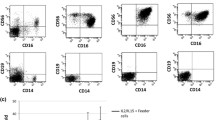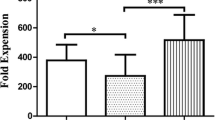Summary
Lymphokine-activated killer (LAK) cells are generated by the culture of peripheral blood lymphocytes with interleukin-2 (IL-2). A variety of cells, including T-lymphocytes and natural killer (NK) cells, can be activated by IL-2 to exhibit the ability to kill multiple tumor and “modified-self” targets. Recent reports indicate that culture conditions can determine the phenotype of cells expressing LAK activity. Using limiting dilution techniques, we first generated cloned LAK cells with three culture conditions: autologous human serum (AHS)+IL-2; AHS+IL-2+0.1 μg/ml phytohemagglutinin and fetal bovine serum and IL-2. We determined that all but one of the 47 LAK cell clones generated with the three culture conditions were CD3+ and T-cell like; one NK-like clone was observed. Clones that were cytotoxic for one target could generally kill multiple targets, and the absence of phytohemagglutinin did not significantly affect the ability of the LAK cell clones to kill multiple targets. The presence of phytohemagglutinin was, however, necessary for the long-term maintenance of proliferation and cytotoxic activity of the LAK cell clones. The mechanism by which LAK cells kill tumor targets is not known. We here demonstrate that LAK cells and LAK cell clones can produce interferon-γ and tumor necrosis factor (TNF) when stimulated with an erythroleukemia cell, K562. Five of the six CD3+, LAK cell clones tested could be stimulated by K562 cells to produce both interferon-γ and TNF. However, the ability of the cloned LAK cells to kill K562 cells, as measured in a 4-h 51Cr-release assay, did not correlate with their ability to produce these cytokines. Furthermore, specific antibodies that neutralize the cytotoxic activity of interferon-γ and TNF did not inhibit killing of K562 cells by LAK cells as measured with a 4-h cytotoxic assay. The cytostatic and cytotoxic activities of interferon-γ and TNF for tumor cells are well documented, but these cytolytic activities are slower acting and exhibit their maximum effect after 48–96 h. We here propose that LAK cells kill tumor targets by a combination of cell-to-cell-mediated killing and by the release of slower acting cytostatic/cytotoxic cytokines that can inhibit the growth of tumors some distance from the effector cells.
Similar content being viewed by others
References
Ahrens PB, Ankel H (1987) The role of asparagine-linked carbohydrate in natural killer cell-mediated cytolysis. J Biol Chem 262:7575
Allavena P, Ortaldo JR (1984) Characteristics of human NK clones: target specificity and phenotype. J Immunol 132:2363
Allavena P, Scala G, Djeu JY, Procopio AD, Oppenheim JJ, Herberman RB, Ortaldo JR (1985) Production of multiple cytokines by clones of human large granular lymphocytes. Cancer Immunol Immunother 19:121
Chong AS-F, Hersh EM, Grimes WJ (1988) Blocking of lymphokine activated killer (LAK) cell mediated cytotoxicity by cell sized beads bearing tumor cell proteins. J Immunol 141:4418
Chong AS-F, Scuderi P, Grimes WJ, Hersh EM (1989) Tumor targets stimulate interleukin-2 activated killer (LAK) cells to produce interferon-γ (IFN-γ) and tumor necrosis factor. J Immunol (in press)
Damle NK, Doyle LV, Bradley EC (1986) Interleukin 2-activated human killer cells are derived from phenotypically heterogeneous precursors. J Immunol 137:2814
Ferrini S, Miescher S, Zocchi MR, Von Fliedner V, Moretta A (1987) Phenotypic and functional characterization of recombinant interleukin 2 (rIL-2)-induced activated killer cells: analysis at the population and clonal levels. J Immunol 138:1297
Ferrini S, Moretta L, Pantaleo G, Moretta A (1987) Surface markers of human lymphokine-activated killer cells and their precursors. Analysis at the population and clonal level. Int J Cancer 39:18
Granger GA, Orr SL, Yamamoto RS (1985) Lymphotoxins, macrophage cytotoxins, and tumor necrosis factors: an interrelated family of antitumor effector molecules. J Clin Immunol 5:217
Grimm EA, Mazumder A, Zhang HZ, Rosenberg SA (1982) Lymphokine-activated killer cell phenomenon. Lysis of natural killer-resistant fresh solid tumor cells by interleukin 2-activated autologous human peripheral blood lymphocytes. J Exp Med 155:1823
Grimm EA, Robb RJ, Roth JA, Neckers LM, Lachman LB, Wilson DJ, Rosenberg SA (1983) Lymphokine-activated killer cell phenomenon. III. Evidence that IL-2 is sufficient for direct activation of peripheral blood lymphocytes into lymphokine-activated killer cells. J Exp Med 158:1356
Herberman RB, Hiserodt J, Vujanovic N, Balch C, et al. (1987) Lymphokine-activated killer cell activity. Characteristics of effector cells and their progenitors in blood and spleen. Immunol Today 8:178
Hersh EM, Scuderi P, Salmon S, Chong A, Grimes WJ (1988) A soluble anti-tumor factor produced during interleukin-2 (IL-2) induced generation of lymphokine activated killer (LAK) cells. Evidence for a dual mechanism of LAK cell action. Proc Am Assoc Cancer Res 29:98
Itoh K, Shiba K, Shimizu Y, Suzuki R, Kumagai K (1985) Generation of activated killer (AK) cells by recombinant interleukin 2 (rIL-2) in collaboration with interferon-γ (IFN-γ). J Immunol 134:3124
Itoh K, Tilden AB, Kumagai K, Balch CM (1985) Leu-11+ lymphocytes with natural killer (NK) activity are precursors of recombinant interleukin 2 (rIL-2)-induced activated killer (AK) cells. J Immunol 134:802
Lotze MT, Chang AE, Seipp CA, Simpson C, Vetto JT, Rosenberg SA (1986) High dose recombinant interleukin 2 in the treatment of patients with disseminated cancer: Responses, treatment-related morbidity, and histologic findings. J Am Med Assoc 256:3117
Mingari MC, Ferrini S, Pende D, Bottino C, Prigione I, Moretta A, Moretta L (1987) Phenotypic and functional analysis of human CD3+ and CD3− clones with “lymphokine-activated killer” (LAK) activity. Frequent occurrence of CD3+ LAK clones which produce interleukin-2. Int J Cancer 40:495
Moretta L, Pende D, Cozzani R, Merli A, Bagnasco M, Mingari MC (1986) T cell nature of some lymphokine-activated killer (LAK) cells. Frequency analysis of LAK precursors within human T cell populations and clonal analysis of LAK effector cells. Eur J Immunol 16:1623
Mule JJ, Yang J, Shu S, Rosenberg SA (1986) The anti-tumor efficacy of lymphokine-activated killer cells and recombinant interleukin 2 in vivo: direct correlation between reduction of established metastases and cytolytic activity of lymphokine-activated killer cells. J Immunol 136:3899
Nedwin GE, Svedersky LP, Bringman TS, Palladino MA, Goeddel DV (1985) Effect of interleukin 2, interferon-γ, and mitogens on the production of tumor necrosis factors α and β. J Immunol 135:2492
Ortaldo JR, Longo DL (1988) Human natural lymphocyte effector cells: definition, analysis of activity, and clinical effectiveness. J Nat Cancer Inst 80:999
Ortaldo JR, Mason A, Overton R (1986) Lymphokine-activated killer cells. Analysis of progenitors and effectors. J Exp Med 164:1193
Owen-Schaub LB, Gutterman JU, Grimm EA (1988) Synergy of tumor necrosis factor and interleukin 2 in the activation of human cytotoxic lymphocytes: effect of tumor necrosis factor and interleukin 2 in the generation of human lymphokine-activated killer cell cytotoxicity. Cancer Res 48:788
Peters PM, Ortaldo RJ, Shalaby MR, Svondersky LP, Nedwin GE, Bringman TS, Hass PE, Aggarwal BB, Herberman RB, Goeddel DV, Palladino MA (1986) Natural killer-sensitive targets stimulate production of TNF-α but not TNF-β (lymphotoxin) by highly purified human peripheral blood large granular lymphocytes. J Immunol 137:2592
Phillips JH, Lanier LL (1986) Dissection of the lymphokine-activated killer phenomenon. Relative contribution of peripheral blood natural killer cells and T lymphocytes to cytolysis. J Exp Med 164:814
Rayner AA, Grimm EA, Lotze MT, Chu EW, Rosenberg SA (1985) Lymphokine-activated killer (LAK) cells. Analysis of factors relevant to the immunotherapy of human cancer. Cancer 55:1327
Rayner AA, Grimm EA, Lotze MT, Wilson DJ, Rosenberg SA (1985) Lymphokine-activated killer (LAK) cell phenomenon. IV. Lysis by LAK cell clones of fresh human tumor cells from autologous and multiple allogeneic tumors. J Natl Cancer Inst 75:67
Roberts K, Lotze MT, Rosenberg SA (1987) Separation and functional studies of the human lymphokine-activated killer cell. Cancer Res 47:4366
Rosenstein M, Yron I, Kaufmann Y, Rosenberg SA (1984) Lymphokine-activated killer cells: Lysis of fresh syngeneic natural killer-resistant murine tumor cells by lymphocytes cultured in interleukin 2. Cancer Res 44:1946
Ruggiero V, Latham K, Baglioni C (1987) Cytostatic and cytotoxic activity of tumor necrosis factor on human cancer cells. J Immunol 138:2711
Sawada H, Abo T, Sugawara S, Kumagai K (1988) Prerequisite for the induction of lymphokine-activated killer cells from T lymphocytes. J Immunol 140:3668
Scala G, Allavena P, Djeu JY, Kasahara T, Ortadco JR, Herberman RB, Oppenheim JJ (1984) Human large granular lymphocytes are potent producers of interleukin-1. Nature 309:56
Scuderi P, Sterling KE, Raitano AB, Grogan TM, Rippe RA (1987) Recombinant interferon-γ stimulates the production of human tumor necrosis factor in vitro. J Interferon Res 7:164
Shiiba K, Suzuki R, Kawakami K, Ohuchi A, Kumagai K (1986) Interleukin 2-activated killer cells: generation in collaboration with interferon-γ and its suppression in cancer patients. Cancer Immunol Immunother 21:119
Silvennoinen O, Vakkila J, Hurme M (1988) Accessory cells, dendritic cells, or monocytes, are required for the lymphokine-activated killer cell induction from resting T cell but not from natural killer cell precursors. J Immunol 141:1404
Skibber JM, Lotze MT, Muul LM, Uppenkamp IK, Ross W, Rosenberg SA (1987) Human lymphokine-activated killer cells: further isolation and characterization of the precursor and effector cell. Natl Immunol Cell Growth Regul 6:291
Sondel PM, Hank JA, Kohler PC (1987) Status and potential of interleukin-2 for the treatment of neoplastic disease. Oncology 1:41
Sverdersky LP, Nedwin GE, Goeddel DV, Palladino MA (1985) Interferon-γ enhances induction of lymphotoxin in recombinant interleukin 2-stimulated peripheral blood mononuclear cells. J Immunol 134:1604
Taswell C (1981) Limiting dilution assays for the determination of immunocompetent cell frequencies. I. Data analysis. J Immunol 126:1614
Tilden AB, Itoh K, Balch CM (1987) Human lymphokine-activated killer (LAK) cells: Identification of two types of effector cells. J Immunol 138:1068
Williamson BD, Carswell EA, Rubin BY, Prendergast JS, Old LJ (1983) Human tumor necrosis factor produced by human B-cell lines: synergistic cytotoxic factor interaction with human interferon. Proc Natl Acad Sci USA 80:5397
Author information
Authors and Affiliations
Additional information
This work is supported in part by grants from the Arizona Disease Research Commission (3364-000000-1-1-AP-6621) and the National Institutes of Health (Grants GM 34121, CA-17094 and CA-23074)
Rights and permissions
About this article
Cite this article
Chong, A.S.F., Aleksijevic, A., Scuderi, P. et al. Phenotypic and functional analysis of lymphokine-activated killer (LAK) cell clones. Cancer Immunol Immunother 29, 270–278 (1989). https://doi.org/10.1007/BF00199215
Received:
Accepted:
Issue Date:
DOI: https://doi.org/10.1007/BF00199215




